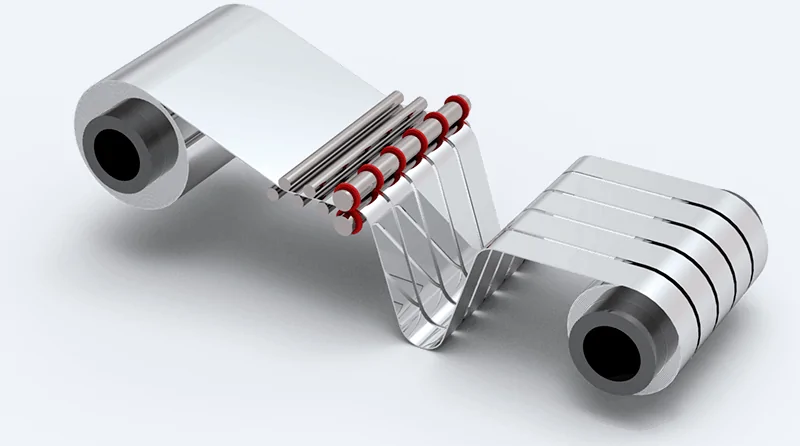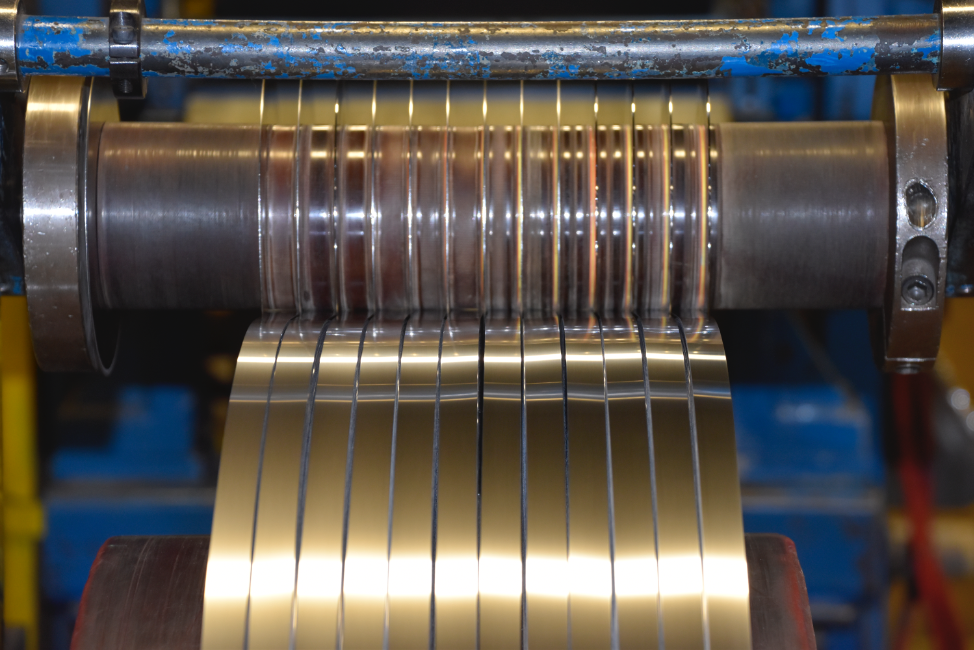In metal manufacturing, achieving the precise size and width of raw material is essential to ensure quality downstream processing. Metal slitting machines are key to achieving this, transforming large coils into specific, narrower widths that can be used in various industries. From automotive parts to electronics casings, the versatility and accuracy of metal slitting make it a crucial process in today’s manufacturing landscape. Let’s dive into what metal slitting machines are, how they operate, and why they’re indispensable.
What Is a Metal Slitting Machine?
A metal slitting machine is designed to slice master metal coils into narrower strips of specific widths, suitable for further fabrication. The machine uses rotary blades, sometimes called knives, to achieve this precision cutting. These hardened knives, arranged above and below the metal strip, rotate at extremely high speeds, ensuring clean and consistent cuts.
The slitting process is essential for providing the correct material dimensions that cater to specific manufacturing requirements. Whether you are producing appliances, automotive panels, or even signage, the metal slitting machine plays a fundamental role in ensuring materials are cut accurately to the necessary specifications.
Components and Working Mechanism of Metal Slitting Machines
To understand how metal slitting machines work, let’s break down the critical components and their roles:
- Uncoiler: This device holds the master coil and unrolls it into the slitting machine. The uncoiler ensures that the material enters the machine smoothly, preventing any irregularities or wrinkles.
- Rotary Knives/Slitting Blades: These knives, mounted on arbors, are responsible for slicing the metal strip into narrower widths. Precision-ground and hardened, these knives can cut through metals ranging from steel to aluminum alloys. The setup often includes both upper and lower knives that rotate against each other, ensuring a clean shear without deforming the material.
- Tension Stand: After the metal strip passes through the knives, the tension stand maintains a consistent force on the material to prevent any slack. This component is vital for ensuring that the slitting process produces straight, defect-free strips.
- Recoiler: Finally, the recoiler gathers the slit strips into smaller coils, preparing them for the next stage of manufacturing or delivery to customers.
The slitting machine is designed with efficiency and flexibility in mind, enabling manufacturers to handle a variety of gauges, widths, and materials.
Types of Metal Slitting Machines
Metal slitting machines generally fall into two primary categories, each serving different needs:
1. Roll Slitters
Roll slitters are commonly used when there is a need to make multiple cuts simultaneously. The machine consists of a series of upper and lower circular knives mounted on shafts, which slice the coil as it moves through the machine. These machines are highly versatile, capable of handling different materials and widths, making them suitable for a wide variety of applications.
2. Slitter Rewinders
Slitter rewinders typically use fewer knives compared to roll slitters and are designed to rewind the material after slitting. They are ideal for creating multiple rolls from a single coil and are particularly beneficial for jobs that require rapid changeovers between different widths. By rewinding slit coils back into tight rolls, they make handling and transportation more convenient.
The Metal Slitting Process Step-by-Step
The metal slitting process is highly technical, involving several coordinated steps to achieve precise results. Here’s a simplified breakdown of the process:
- Loading the Coil: The first step involves loading a master coil onto the uncoiler. Operators must ensure that the coil is aligned properly for consistent feed.
- Setting Up the Slitting Blades: The blades are then positioned to the desired widths. This step is crucial, as any misalignment can lead to incorrect slit sizes or edge defects.
- Feeding the Coil: The metal coil is fed through the slitting blades at a regulated speed. Speed regulation is important to prevent waviness or edge imperfections.
- Slitting: As the coil moves through, the rotary knives shear the metal into the required number of strips, each with the exact specified width.
- Recoiling: Once the strips are slit, they are wound onto recoilers, forming smaller coils that can be further processed or shipped.
Additional Features and Innovations
Modern slitting machines come equipped with a range of features that improve precision, efficiency, and safety. Some of the notable innovations include:
- Programmable Touch Screens: Operators can now control and monitor the entire slitting operation via touchscreens, allowing for rapid setup and adjustments.
- Chromed Shafts: Some slitting machines are equipped with chrome-coated shafts to minimize wear and tear, reduce the risk of rust, and improve longevity.
- Edge Trimming and Surface Inspection: To maintain high-quality standards, many machines are fitted with edge trimming units to remove any rough or irregular edges. Surface inspection systems can also detect imperfections, ensuring only defect-free coils are processed further.
- Quick Changeover Capabilities: Machines that enable quick changeover of slitting knives and setups allow manufacturers to switch between different coil specifications rapidly, saving time and boosting production efficiency.
Advantages of Using Metal Slitting Machines
There are several advantages to using metal slitting machines as part of your manufacturing process. These benefits highlight why slitting is preferred over traditional cutting methods such as sawing or manual shearing.
- Precision and Accuracy: Slitting machines can produce metal strips with extremely tight tolerances, which is crucial for components that require precise dimensions, such as automotive parts and electronics.
- Increased Efficiency: Slitting metal is significantly faster than manual cutting processes. With high-speed slitting capabilities, manufacturers can cut large quantities of metal into precise widths in a fraction of the time.
- Cost-Effectiveness: The automated nature of slitting machines reduces labor costs and material waste. The precision of the process also means there is less scrap, making it a cost-effective option for high-volume production.
- Versatility: Metal slitting machines are versatile enough to handle a wide range of materials, including steel, stainless steel, aluminum, and specialty alloys. This makes them suitable for industries as diverse as automotive, construction, and appliance manufacturing.
- Enhanced Edge Quality: Unlike traditional cutting, which can leave rough or jagged edges, slitting provides clean, razor-sharp edges that are essential for downstream processes such as welding or stamping.
Applications of Metal Slitting
The versatility of metal slitting machines makes them suitable for a wide variety of applications across many industries:
- Automotive: Metal slitting is used to prepare materials for vehicle bodies, chassis components, and other automotive panels.
- Construction and Furniture: Materials used for frames, panels, desks, and cabinets are often slit to the required specifications using metal slitting machines.
- Appliances: Components for washing machines, refrigerators, and ovens frequently require slit metal strips to fit precise dimensions.
- Electronics: Metal slitting is employed to produce casings, frames, and other parts for various electronics, where precision and clean cuts are critical.
- Signage and Packaging: Slitting machines produce the exact width of metal strips needed for making signs, billboards, and even certain forms of packaging.
Innovations in Metal Slitting Technology
The latest advancements in metal slitting technology have focused on improving automation, precision, and material handling capabilities:
- Servo Drives and Automation: Incorporating servo motors into slitting machines allows for more precise positioning of the knives and faster adjustments. This helps in achieving tighter tolerances and reducing cycle times.
- Smart Monitoring Systems: Many modern slitting lines now include automated monitoring systems that provide real-time feedback on parameters such as slit width, tension, and coil weight. This reduces the chance of errors and helps in maintaining consistent quality.
- Environmental Considerations: Improved efficiency means that metal slitting processes now produce less waste and require less energy, making them more environmentally friendly.
Conclusion
Metal slitting machines are an integral part of modern manufacturing, providing precision, efficiency, and versatility to industries that require metals cut to exact dimensions. Whether you’re working in automotive, construction, or electronics, the advantages offered by metal slitting—from enhanced accuracy to reduced production costs—make it an invaluable process.
As innovations continue to improve the technology, we can expect even greater levels of automation, precision, and efficiency, ensuring that metal slitting remains a cornerstone of high-quality metal fabrication for years to come. By understanding the components, types, and benefits of these machines, manufacturers can make informed decisions that optimize their production capabilities and maintain competitive quality standards.


